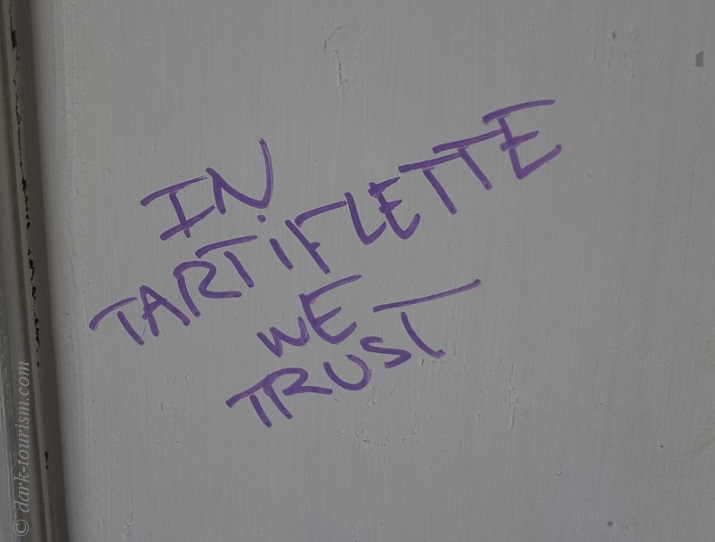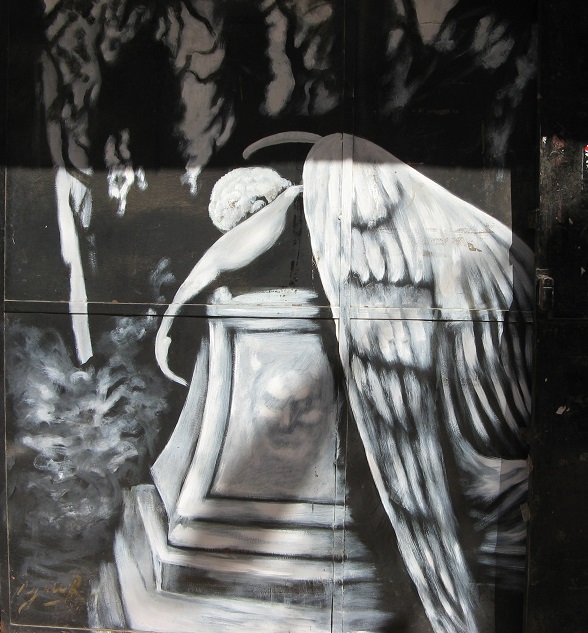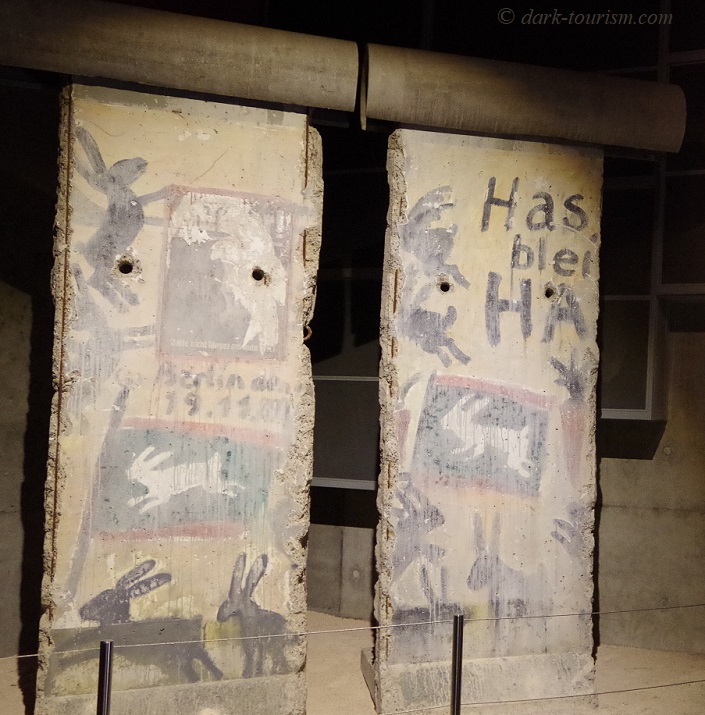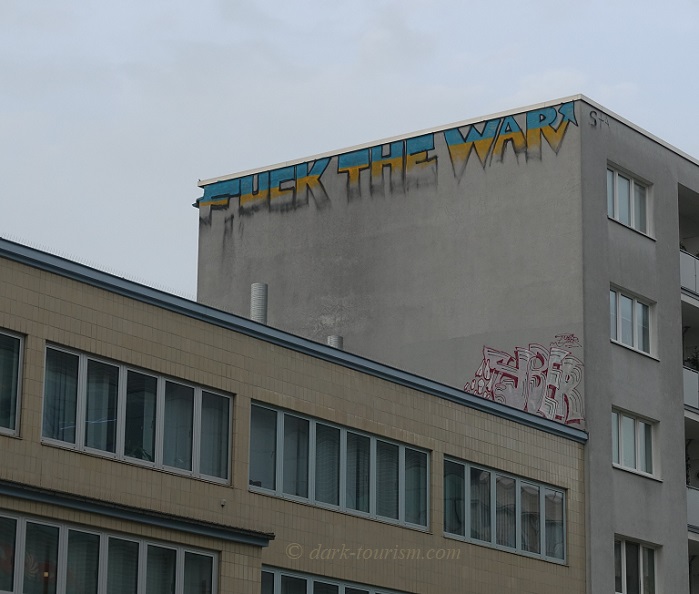This is the theme that in the latest poll, as at the bottom of this post, narrowly came second, beaten by just one vote by DT & Bullet Holes, which became the previous Blog post. As I would have voted for Graffiti myself I then decided to compose and post this now without another poll. But I won’t let themed polls become forgotten again. There’ll be new ones before too long. Promise.
So now to this post’s theme of DT & Graffiti – but first I have to reiterate the warning already made in the poll: this topic will contain some strong language, in particular the “F-word”, but I’ll leave those for the last six of the 25 photos to feature here. So if you don’t want to see those images then don’t read on beyond photo No. 19. (But if it’s only those you want to see, go on and scroll straight down to photo No. 20 …)
As the first photo I picked one of my favourites as far as graffito go, namely one I spotted in Tel Aviv, Israel, back in 2006 (before I had even heard of dark tourism!). I love the way in which the two slogans sprayed on some public benches so contradict each other:

Graffiti can be drastic, subtle, offensive, clever, mysterious, in-your-face, artistic, simplistic and sometimes downright annoying. Let’s get an example of the latter out of the way early on. Here’s a totally disgraceful example featuring swastikas on the remnants of a Jewish cemetery in Suwalki in eastern Poland:

It has always puzzled me how such neo-Nazi doodles can appear in a country that suffered so much at the hands of the Nazis. And the fact that this graffiti was daubed on relics of a Jewish cemetery that had been destroyed by the German Nazis in WWII, means that the place has been defiled twice. Note, however, that whoever was responsible for these graffiti didn’t even manage to get the swastika symbol right (even though you can still make out what is meant)! Both attempts have gone somewhat wrong. That may also say something about the intellectual capacities of the graffito dauber in question …
Not quite as offensive, but also totally disrespectful and inappropriate was that big red slogan that was painted above the entrance to the legendary Buzludzha Monument in Bulgaria when I saw it in 2011 (meanwhile the lettering has been painted over):

I’ve also seen graffiti in the Exclusion Zone of Chernobyl, some of which was quite unwelcome. But here’s a counterexample, a cute and artistic graffito in the style of the famous graffiti artist Banksy, spotted near the dysfunctional lift doors inside an apartment block in the ghost town of Pripyat (same photo as the featured one at the top of this post):

The next photo has already featured on this Blog before, over a year ago in this post about Belfast and the Titanic. Amongst the Titanic-related pictures in it was this one showing a crude depiction of the great ship to which someone had added the graffito “it sank”, thus de-glamourizing the Titanic heritage:

Also already featured on this Blog before is this next photo from the Copenhagen post of last September:

This is one of the many doodles left by probably quite bored German soldiers during the occupation of Denmark by Nazi Germany in WWII. The one scratched on to the brick in the centre here is remarkable insofar as it adds to the famous Goebbels quote “Wollt ihr den totalen Krieg?” (‘Do you want total war?’) not the resounding “Ja!” of the original recording of the speech that had this as it core line, but a defiant “Nein” (‘no!’) underneath it. This could have had serious consequences for the soldier in question had he been caught while leaving this on this wall.
Another anti-Nazi graffito, this time a contemporary one, is this example that I spotted on my recent return visit to my original home city of Hamburg in April (see also this post):

The “HH” is short for “Hansestadt Hamburg” and is also the abbreviation for the city on car registration plates. Unfortunately this graffito does not speak for all citizens of Hamburg – the far-right edge may have a weaker footing in this city than elsewhere in Germany, but it isn’t non-existent.
A rather subtle reference to Nazis can be seen in this marvellous graffito spotted inside one of the buildings in the ghost town of Kolmanskop, Namibia:

This imaginary bird’s feet, and the footprints they leave, do have a cunning resemblance to swastikas … moreover it’s labelled a brown “crossfoot”, with brown obviously having been the preferred shirt colour of the Nazis in Hitler-era Germany, and the “cross” can also be seen as a very subtle reference to the “Hakenkreuz” (‘hook cross’, as the German word for ‘swastika’ would translate literally).
No Nazi references here, and indeed nothing dark in itself as such, when it comes to the graffito in the next photo, also spotted in one of the abandoned buildings in Kolmanskop:

For those of you who don’t know: Tartiflette is an Alpine French dish, a potato and onion bake topped with melted Reblochon cheese (there are also variants with other cheeses and it may or may not contain lardons or bacon). It’s a hearty, tasty dish, but I didn’t expect its deification in this graffiti form in as forlorn and faraway a place as Kolmanskop in the middle of the Namib Desert …
A place where I found more, and more artistically appealing, graffiti than almost anywhere else was the coastal city of Valparaiso, Chile. Here graffiti art is clearly revered. Few were in any way dark, but this rather Gothic-y one whose depiction resembles a tomb should qualify:

The next graffiti I spotted on a wall in Lisbon, Portugal. It calls for civil disobedience, a classic in non-violent resistance at least since Gandhi’s time, and involves a version of a famous and iconic image of such resistance, namely the “Tank Man” of Tiananmen Square standing solitarily in front of tanks during the protests in China in 1989.

A similar resistance-motivated graffiti, though somewhat less non-violent, is the following example encountered in Santiago de Chile:

The guitar has been hailed as a kind of “weapon” of protest and resistance throughout most of the history of rock music (I have “The Power of Guitar and Drums” by Northern Irish punk outfit Stiff Little Fingers in my head right now), but here it’s taken literally as a physical weapon against riot police – or maybe it’s just meant symbolically after all …
A historically famous place for graffiti was the Berlin Wall – albeit only on one side, of course, namely the one in West Berlin. After the Wall was dismantled in the wake of the peaceful revolution in the GDR in 1989/90 many of its segments ended up in museums and other public spaces around the world. Here’s a display of two such segments at the Memorial de Caen in Normandy, France:

The graffiti on these segments is unusually apolitical and rather cute, what with all those little bunnies. The writing on the left segment indicates that this graffito was applied after the opening of the border on 9 November 1989, so when the Wall had already ceased to be the nearly insurmountable barrier between East and West. The writing on the right segment is incomplete but probably said “Has(e) bleibt Has(e)” (roughly ‘hares will be hares’). Whether this is supposed to have any deeper meaning, I don’t know – any guesses?
The next graffito is plainer to interpret. It too features on a section of the Berlin Wall, this time still in Berlin itself, namely at Niederkirchnerstraße, bordering the Topography of Terror memorial.

The bottom two thirds of this stretch of Berlin Wall are heavily damaged – that’s the result of what became known as “Mauerspechte”, the people who chiselled away at the Wall after its opening either out of pure destructive zeal or for souvenirs to take home (or to sell to tourists – a practice still encountered in Berlin today, although the pieces have become smaller and smaller and ever pricier over the years). The informal expression “Mauerspecht” is a reinterpretation of the word for an actual bird, and in English it was sometimes rendered as ‘wallpeckers’ (in allusion to woodpeckers), which works quite well, I think. Anyway, the graffito saying “madness” above the chisel line survived and can stand symbolically for the entire concept of the Wall and the Cold-War-era division of the world … a madness that has of course returned now, if in a somewhat different form (without the baggage of the communism-capitalism divide, just pure brutal imperialism).
Moving on far away to the other end of the world, here’s a protected graffito in Balibo, East Timor:

This graffito was applied to the outer wall of a house that was occupied by five journalists working for a news network from nearby Australia, hence the word and the rendition of the Australian national flag. The reporters were in Balibo to cover the invasion of East Timor by Indonesia in 1975. They had hoped that by marking the house they were staying in they could prevent themselves from being targeted by the Indonesian forces. Tragically they were wrong. Indonesia clearly did not want any independent media coverage of their illegal invasion and killed the five journalists on the spot. The subsequent cover-up was shamefully also accepted by the then Australian government. It took decades before an official inquest in 2007 revealed the truth about the “Balibo Five”, as they became known.
Back to Europe, actually to the city where I live now, Vienna. Here I once spotted this:

Seeing this, my eyebrows were raised in great surprise – was there really a psychological condition of being afraid of me … or other Peters?!? Meanwhile I’ve found out that there is a New-York-based German illustrator of the name Peter Phobia (probably an artist’s pseudonym), so maybe it’s a reference to him … but I can’t be sure.
Another graffito I found mysterious (and still do) is one I came across during a little spot of urbexing in Bulgaria, near an abandoned steelworks, where the plant’s own ex-train station had this line seen here in the bottom right corner of the image:

“The war is still on”?? What war??? Bulgaria hasn’t been in a war since WWII, and that’s not been on for nearly eight decades. So what is this referring to? It remains indeterminable to me.
In contrast, there is absolutely no question about what this next elaborate piece of graffiti is referring to:

I found this in Albania’s capital Tirana on my visit to the city in April 2022, so relatively shortly after the beginning of Putin’s invasion of Russia’s neighbour Ukraine in February that year.
On the same trip, in a different part of Tirana, I also came across this almost endearing graffito of Albania-Ukraine solidarity:

That was photo No. 19 … and so at this point I have to reiterate my warning already made at the beginning of this post: the remainder of this post will feature graffiti that all contain the “F-word”. So if you don’t want to see those stop scrolling right now and leave this post.
OK, then, for all readers still with me, let’s get going (or “effing”, more like):
The first of this series of graffiti is another reference to the Ukraine war (indicated by the national colours: blue above yellow), spotted on my recent visit to Berlin (see also this earlier post) high on a building’s outer wall in the district of Charlottenburg:

The same line I also encountered much earlier once in Mostar, Bosnia & Herzegovina, during my visit there back in 2009. It’s on a war ruin and quite obviously a reference to the Yugoslav wars of the 1990s:

Probably more controversial to some will be the next graffito involving the “F-word”, spotted in Lisbon, Portugal, in January 2013 (so when the German Joseph Ratzinger was still Pope Benedict XVI):

Of course one cannot help being intrigued by what used to follow that arrow and the syllable “in” after the word “Pope”. As it’s been sprayed over in grey colour we cannot know and have to use our imagination …
The next “F-word” graffito, spotted in Nicosia, Cyprus in January 2023, is clearer, though you have to wonder what population is meant here – the whole world’s? Might actually make the most sense …

A fabulous place for seeing graffiti art of a high level of execution and artistic merit is at Teufelsberg, Berlin, where more or less famous street artists are actually invited to come and leave their works of art. Many I saw there were indeed spectacular. The photos of the dozens and dozens of graffiti that I took there in 2016 could have filled a whole blog post of its own. But since I wanted this post to have a more international spread, I’ve limited myself to picking out just one. And given its position in this post it had to be this:

This orgy of amassed “F-words” has many of the usual countercultural/subcultural targets and many more, some a bit more surprising (Obama even features twice). The one I could get most behind of is that anti-Facebook bit (because I’m a victim of that company myself – full story here). Selfies I also find an appealing target (I don’t take any and don’t like the reflex-like way in which so many smartphone users selfishly take them at every turn). But pickles?!? What’s wrong with those? Anyway, what an onslaught of “F-words”, eh?
Finally, I bring you another one of my absolute favourite graffiti I’ve ever seen and it still makes me chuckle every time I see it to this day. I spotted it in the small town of Varshets in Bulgaria – and it takes us back to the topic of beaches (like in this previous Blog post):

I have a feeling, though, that beaches may not actually have been the intended target here. The dauber’s command of English is evidently flawed, as can be seen by the misspelling of the “F-word” itself and also the correction on the “of”, though they still didn’t get it right – they must have meant “off”, naturally. So I have the suspicion that “beach” is also a misspelling, namely of a similar word but pronounced with a short < ı >.
But with this I shall come to a close. I hope you’ve enjoyed reading this unusually-themed post, especially those not too averse to a bit of strong language …




One Response
very interesting, thank you..